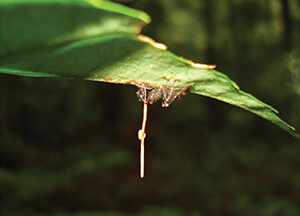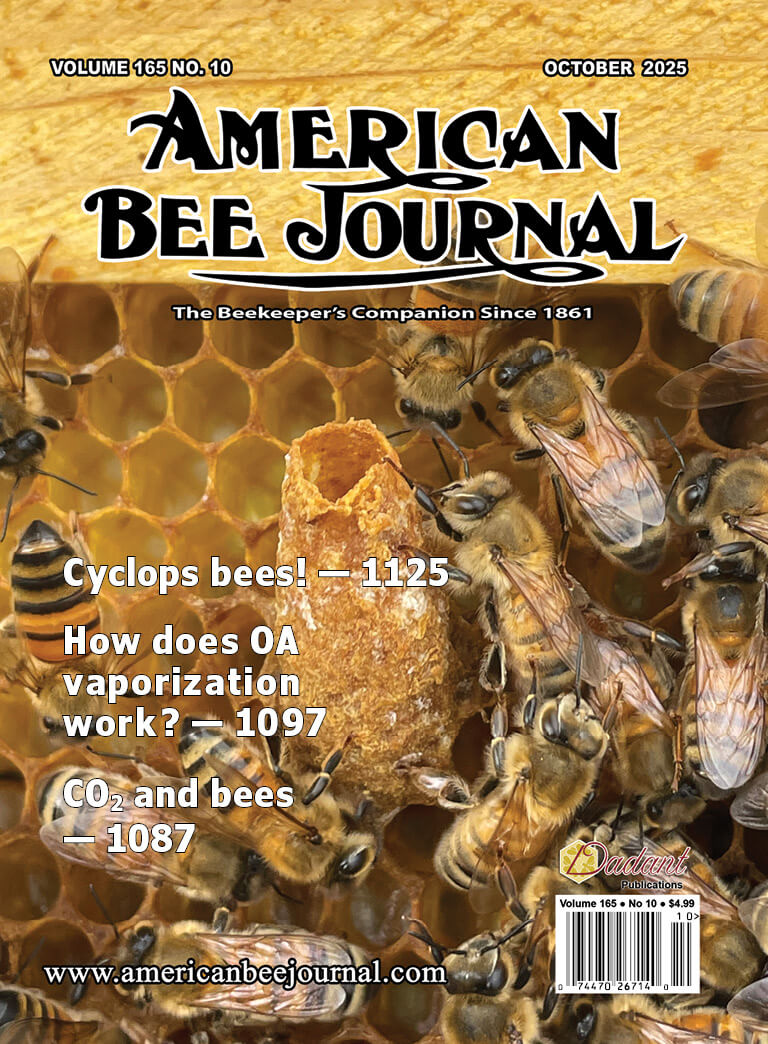
Researchers at Washington State University aim to develop the biocontrol agent as a commercial product
Deep in the Brazilian rainforest, if you look closely enough, you might find a gruesome scene: Like a sinister sewing pin, a fungal plume sprouts from an ant’s body. The ant, still hopelessly clinging to a leaf even after death, finds itself in this position because the fungus (Ophiocordyceps unilateralis, also known as the “zombie ant fungus”) commandeered the ant’s brain, urging it to climb up the plant’s stem to a location with prime conditions for fungal growth. The fungus then killed the ant from the inside out, using its body as nourishment.
Ants aren’t the only victims who might become fungus food. Varroa mites, too, can succumb to pathogenic fungi, and researchers at Washington State University are using this susceptibility as a new method of varroa control. Drs. Jennifer Han, Steve Sheppard and their colleagues have developed a strain of Metarhizium brunneum — a fungus that looks like a dark mold — that can be introduced to honey bee colonies, achieving mite kills similar to an oxalic acid drizzle.1
Molding the mold
“Metarhizium has several qualities that made it an excellent candidate [treatment],” says Han. “In the early 2000s the USDA performed initial studies that showed that Metarhizium could kill varroa and that it was safe for bees, but available strains lacked consistent performance in the field.” This is because despite their ability to infect and kill mites, the naturally occurring strains did not grow well at hive temperatures; rather, they prefer a cooler environment.
But Han tried infecting varroa in honey bee colonies anyway. Luckily, despite the suboptimal growing conditions, enough of the fungal spores successfully germinated and infected varroa that Han could isolate fungus from those specific mites and culture it again in the laboratory. This gave her a fungal population which she knew could infect and kill varroa in a beehive, then she gradually coaxed the fungus to grow even better at hive temperatures.
To do this, she used a process called “directed evolution” — the same concept scientists use to coax bacteria to produce the cold-tolerant enzymes we add to laundry detergent to break down dirt and grime in our cold-water laundry cycles. Han cultured the fungus at incrementally increasing temperatures, starting with the preferred temperature (27°C or 80.6°F) and ending at hive temperature (35°C or 95°F). With each round of culturing, the researchers also applied a mild mutagen, which causes random changes in the genetic code.
The idea is that, with enough random mutations, at least some of them will happen to improve the fungus’s thermal tolerance. Those spores that can still grow as the temperature increases are selected and perpetuated to the next generation. That generation is grown at a slightly higher temperature, and the process is repeated until tolerance of the desired temperature is achieved. By the end of the program, the fungus has accumulated the useful mutations it needs to be able to tolerate the new conditions.
Han says that the new strain of Metarhizium is better able to grow and survive at beehive temperatures, and field trials show that the fungus is able to kill varroa. “When the experiments clearly demonstrated we had developed a thermotolerant strain that germinated and grew better at hive temperatures, I had to immediately repeat the trial to verify the results,” Han says. “I couldn’t believe how well it had worked.”
This fungus is also common in the environment, so introducing it into beehives poses little environmental risk. The bees themselves are protected from the fungal spores by the hairs covering their bodies, and even if spores do reach their exoskeleton, they fail to germinate. Metarhizium brunneum is even already available as a commercial product to control ticks, which are in the same taxonomic class as varroa, but this strain is not specially adapted to beehives like Han’s.
Bring back the virulence
However, once it was adapted to growing in hive conditions, the fungus wasn’t able to kill the mites right away. When Han first tested the hive-tolerant strain, only about 3% of the dead mites collected from the bottom of the hives were actually infected with the fungus.
Han suspected that this poor infection rate was because the temperature-attenuated strain had lost some of its virulence during the lab selection process. To regain virulence, she again isolated fungus from the few infected varroa, sub-cultured the spores, and reintroduced it to hives, which resulted in about 50% of the dead mites succumbing to death by mycosis — a huge improvement, which may get even better with more selection.
The colonies treated with Han’s new and improved Metarhizium strains had slower mite population growth than untreated control colonies. Still, despite being delayed, mite levels in both groups of colonies were comparable by the end of the summer. The researchers also haven’t yet compared Metarhizium-treated colony survival or mite population growth to colonies treated concurrently with status quo miticides. And although mite kills were similar to an oxalic acid application in one experiment, the drizzle is not a typical treatment during the summer when brood are present. So, we don’t yet know if the fungus offers an improvement over the standard treatments, in terms of colony outcomes.
Still, the results are promising. Beekeepers have been craving alternatives to miticides ever since cases of miticide resistance started to show up, and breeding and distribution of mite-resistant bees is not yet feasible for most beekeepers. Even if the Metarhizium approach to varroa control isn’t yet good enough to replace chemical miticides, it can probably still be refined through more rounds of selection.
Han and Sheppard are currently working on developing hive treatment methods that are suitable for the beekeeping industry — in their experiments, they applied the fungus by inverting the mold-covered Petri culture dishes on top of the hives, but those disks are not a shelf-stable, commercially viable product.
“We do believe there is room for improvement and we are continuing our selection program,” Han says.
“We hope to either develop the commercial product ourselves or license the production to existing businesses.” Han and her colleagues are currently working on patenting their hive-adapted strain and testing different application methods. If their product can eventually gain approval from the Environmental Protection Agency, the researchers hope that it will become widely used by beekeepers.
Resistance to resistance
Because the mechanism of fungal infection is so complex, mites are much less likely to become resistant to fungal biocontrol agents than hard miticides, which target specific genes. “It is much more difficult for an organism to ….


